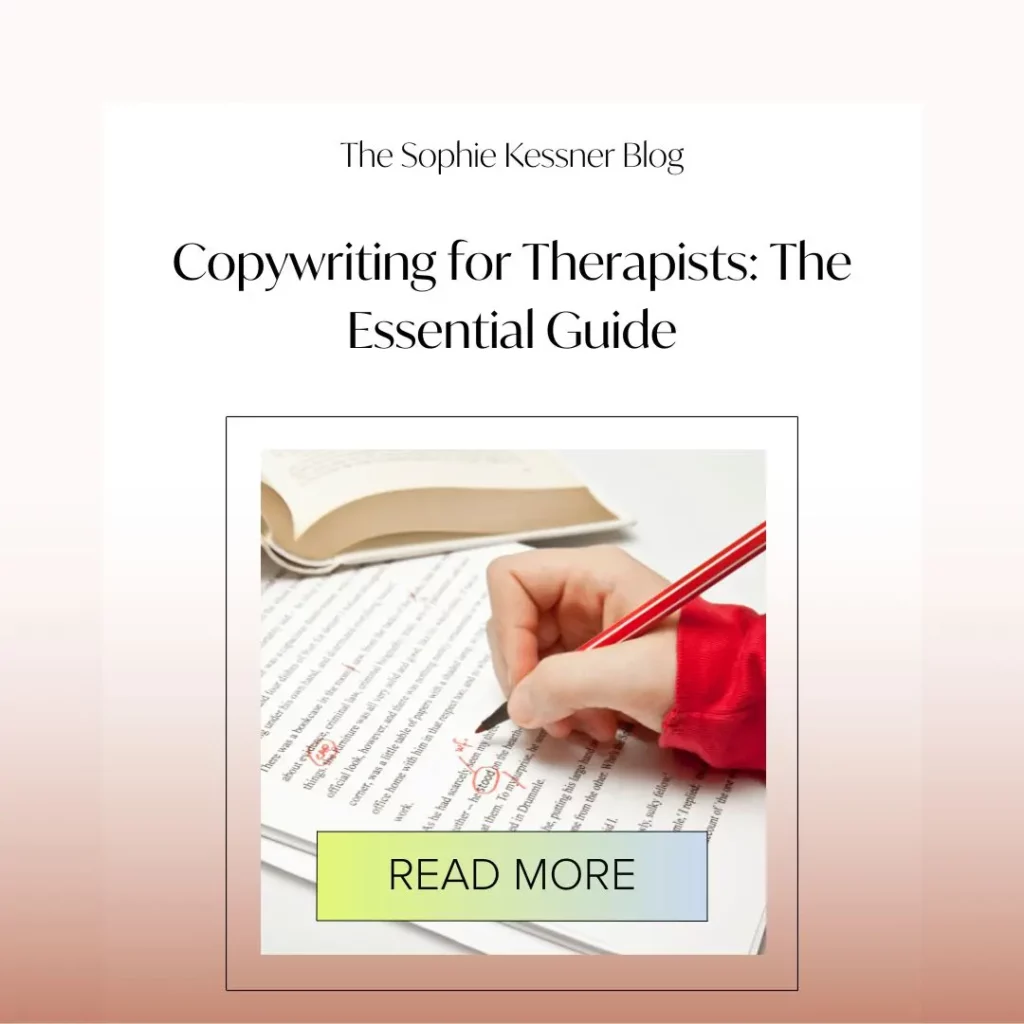Writing for your therapy website doesn’t have to be overwhelming. In fact, it should feel like you’re having a conversation with someone who needs your help. Too many therapists get stuck trying to sound “professional” or “polished” and forget that genuine, relatable writing is what truly connects with potential clients.
Did you know that 80% of patients turn to search engines to learn about medical conditions? This shows just how crucial it is for your website to be discoverable and offer the information they’re looking for. If your content speaks to their needs and shows you understand their struggles, it can make all the difference in getting them to reach out.
This guide will give you simple, straightforward tips to help you write website copy that resonates with the people who need your services most. Whether you’re working on your “About” page, service descriptions, or blog posts, you’ll learn how to write with confidence and create content that speaks directly to your audience. Blog posts are particularly important as they can attract potential clients by providing valuable information and engaging content that converts readers.
You don’t need to be a marketing expert or a professional writer to create a compelling copy—just a few practical strategies can make a world of difference. Let’s dive in and get you started!
Why Copywriting Matters for Therapists in Private Practice
Your website is often the first place potential clients will interact with you. A well-designed therapist website is crucial in attracting clients by providing clear navigation, personalized content, and engagement strategies like blogging. Before they book a session, they’ll read your homepage, check out your services, and maybe glance at your blog. The words you use on these pages can make or break their decision to reach out.
Good copy builds trust. Therapy is deeply personal, and people want to feel safe and understood before making that first contact. The right words can create a sense of trust by showing you’re knowledgeable and approachable.
It’s also essential for SEO. When your copy is written well and includes the right keywords naturally, search engines like Google are more likely to direct the right people to your site. But it’s not just about pleasing search engines—it’s about meeting potential clients where they are, addressing their concerns, and offering solutions they can connect with.
Most importantly, great copy helps you convert visitors into clients. It’s not enough to just list your services—you need to show visitors how you can help them feel better, more in control, and supported.
When your website copy speaks directly to your ideal clients’ needs and emotions, it opens the door to meaningful connections. By showcasing your authenticity and unique aspects of your personality and interests, you can better connect with potential clients who resonate with your true self, ultimately making you more appealing and relatable.
Understanding the Therapy Audience

When you’re writing for therapy clients, it’s essential to connect with their emotional needs. People seeking therapy are often dealing with challenges like anxiety, depression, trauma, or stress. Your copy should address these pain points directly, making it clear that you understand their struggles and offer a solution. Understanding and defining your ideal client allows you to tailor your messaging effectively, ensuring it resonates with the right audience.
Tone and Language: Keep your tone warm, compassionate, and empathetic. Avoid using clinical or cold language that might make potential clients feel more isolated. Instead, write in a way that feels like a conversation, using simple, relatable language that shows you care.
Building an Authentic Brand Voice: Your voice is what sets you apart. Be honest and genuine in your writing—it’s okay to let your personality shine through. You’re not just offering services; you’re offering a safe space for clients to grow and heal. Craft a voice that reflects this, and you’ll connect with the people who need you most. Emphasize the importance of a strong therapeutic relationship by fostering trust and connection through empathetic communication. This approach helps create a safe environment for clients to open up and engage effectively in therapy.
When your copy feels human and compassionate, clients will feel more confident in reaching out for support.
Core Copywriting Strategies for Therapists

Effective copywriting for therapists goes beyond just listing services—it’s about connecting with your audience and encouraging action. Writing copy that resonates with your audience is crucial for engagement and conversion. Preparing effective marketing materials is essential for capturing the target audience’s attention and conveying your unique voice and services. Here are some key strategies to help you write compelling, ethical, and engaging copy.
Crafting Compelling Headlines and Introductions
Your headline is the first thing people see, so it needs to grab their attention. Headlines play a crucial role in attracting prospective clients by making a strong first impression. Focus on their pain points and how you can help. For example, instead of simply writing “Therapy Services,” try something like: “Feeling Overwhelmed? Therapy Can Help You Find Calm.” This speaks directly to a potential client’s feelings and entices them to read more.
Storytelling Techniques
People connect with stories, not just facts. Share real-life examples of how your therapy has helped others (without violating confidentiality, of course). Highlighting the importance of the therapeutic relationship in these stories can demonstrate how authentic communication and trust-building have led to successful outcomes. A short success story can illustrate your expertise and build trust. For instance, you might write about a past client who found relief from anxiety through your approach, while keeping the details anonymous.
Developing an Empathetic Voice
Developing an empathetic voice is crucial for mental health professionals looking to establish a strong online presence. An empathetic voice helps create a sense of connection and understanding with potential clients, making them feel seen, heard, and understood. To achieve this, focus on using language that is warm, approachable, and non-judgmental.
When writing website copy, aim for a tone that feels conversational and relatable. Use everyday language, avoid jargon and technical terms, and highlight the benefits of therapy rather than just listing features. This approach helps create a sense of rapport with potential clients, making them more likely to engage with your services.
In addition to an empathetic tone, create website content that is informative and helpful. This can include blog posts, articles, and other resources that provide valuable insights on mental health topics. By offering valuable content, you can establish yourself as an expert in your field, build trust with potential clients, and attract new clients to your practice.
Storytelling techniques can further enhance your empathetic voice. Share personal anecdotes, case studies, or testimonials from past clients (while maintaining confidentiality). These stories create a sense of authenticity and vulnerability, making potential clients feel more comfortable and at ease.
Overall, developing an empathetic voice is essential for establishing a strong online presence. By using a warm and approachable tone, creating informative content, and incorporating storytelling, you can create a sense of connection and understanding with potential clients, making them more likely to engage with your services.
Developing Persuasive Call-to-Actions (CTAs)
Your CTAs should feel inviting and gentle. Instead of a pushy “Book Now,” try “Ready to start your healing journey? Let’s talk.” Make it feel like the first step, not a sales pitch.
Ethical and Legal Considerations
When writing, always keep client confidentiality and privacy in mind. Avoid using specific case details without consent. Be clear about your qualifications and services, ensuring everything complies with ethical and legal standards in therapy practice.
By using these strategies, you’ll create a copy that is not only persuasive but also aligns with the compassionate and professional nature of therapy.
Integrating SEO with Website Content Copywriting

When it comes to therapy websites, SEO isn’t just about getting found—it’s about connecting with the right people at the right time. Engaging website visitors through valuable content is crucial for building trust and connection. Over 55% of healthcare marketers** consider improving SEO their top priority.** This highlights the importance of ensuring your website is visible and strategically designed to attract those who need your services the most. Wellness practitioners play a crucial role in enhancing overall mental health, making it essential to feature their expertise prominently. Here’s how to integrate SEO into your copy while keeping it natural and helpful.
Keyword Research for Therapists
Start by identifying the keywords your ideal clients are searching for. Tools like Google Keyword Planner or Ubersuggest can help you find terms like “therapy for anxiety” or “online therapy for stress”. Aim for keywords that are relevant to your services and also feel authentic—don’t stuff your content with keywords, as this will make it sound forced.
On-Page SEO Techniques
Optimize your headlines, meta descriptions, and body copy by incorporating your keywords in a natural way. For example, use your keyword in the first 100 words, and ensure it’s present in your title, headers, and image alt texts. However, always prioritize quality and readability—your copy should flow naturally and sound like a conversation, not an SEO checklist.
Balancing SEO with User Experience
SEO can help attract visitors, but it’s the content that keeps them there. Write with your audience in mind, ensuring your content is helpful, empathetic, and easy to understand. When you balance search engine optimization with high-quality, user-focused content, you’ll attract the right clients while building trust.
By integrating SEO seamlessly, you ensure that your website is both visible and genuinely helpful to those who need your services most.
Multi Channel Content Strategy
As a therapist, your content strategy doesn’t have to be limited to your website. By using multiple channels, you can reach more people and build a stronger connection with your audience. Effective copywriting services are crucial for private practice, as they help tailor your marketing content to reflect your unique values and therapeutic presence. Here’s how to adapt your copywriting across different platforms.
Website Copy vs. Blog Posts
Your website copy should be clear, concise, and focused on client conversion—the goal is to make it easy for people to understand what you do and how you can help. Blog posts, on the other hand, give you the chance to dive deeper into specific topics. Use blogs to address common concerns, share success stories, or give helpful advice. Blog posts should be more informative and detailed, while website copy is about making a strong first impression.
Social Media & Email Campaigns
For social media, keep your copy short and impactful. Focus on engaging posts that prompt conversation, like tips or quick resources. Email campaigns should provide value—offer exclusive content, updates, or encouragement to stay engaged. Both platforms require you to stay personal and approachable while delivering helpful, relevant content.
Content Repurposing
Don’t hesitate to repurpose your blog content for social media posts, email newsletters, or even video scripts. A well-crafted blog can be broken into bite-sized social media posts or email segments. This strategy maximizes your content’s reach and ensures consistency across your channels.
Repurposing helps save time and ensures your message stays consistent, no matter where potential clients find you.
Tools, Templates, and Expert Insights
To make copywriting easier and more efficient for therapists, it is crucial to focus on writing copy that resonates with your target audience. Finding suitable copywriting services based on your project scope and budget can also significantly enhance the quality of your marketing content. Here are some tools and resources that can help you streamline the process while maintaining high-quality content.
Copywriting Tools & Resources
There are a number of tools available to help you write, edit, and optimize your website copy:
Grammarly: This tool checks for grammar, spelling, and style, ensuring your writing is polished and error-free.
Hemingway Editor: Helps you simplify complex sentences, making your copy more readable.
Canva: While mostly known for visuals, Canva offers easy-to-use templates for social media posts and blogs, making your content visually engaging.
Google Keyword Planner: Use this for keyword research to ensure your content is optimized for search engines.
Additionally, many therapists find content templates helpful for structuring their service pages, bios, or blogs. Templates can guide you, ensuring consistency while saving you time.
Expert Insights
“Creating authentic, empathetic content is key. Don’t be afraid to show your personality and your passion for helping others,” says Sarah Thompson, a seasoned copywriter for therapists. “Clients are looking for someone they can trust. Your copy should reflect that.”
These tools and expert tips can help you write compelling, high-quality copy that connects with potential clients and grows your therapy practice.
Actionable Tips & Step-by-Step Framework
Writing effective therapy copy is an ongoing process, but breaking it down into simple steps will help you stay on track. Understanding your ideal client is crucial to crafting content that resonates and attracts prospective clients. Here’s a clear, step-by-step guide to help you plan, draft, and refine your website copy.
Step-by-Step Guide:
1. Define Your Audience:
Start by clearly identifying who you’re writing for—whether it’s clients dealing with anxiety, trauma, or stress. Understand their pain points and needs.
2. Research Keywords:
Use tools like Google Keyword Planner or SEMrush to find keywords relevant to your practice, such as “online therapy” or “mental health therapist.”
3. Create a Structure:
Before writing, outline the sections of your page (e.g., Introduction, Services, About, Contact). This keeps the content organized.
4. Write the First Draft:
Focus on getting your ideas down without worrying too much about perfection. Use a conversational, empathetic tone.
5. Refine Your Copy:
After the first draft, refine your copy for clarity, flow, and tone. Keep sentences concise and easy to read.
6. Optimize for SEO:
Ensure your keywords are included naturally in headlines, meta descriptions, and throughout the body text.
7. Include a Call to Action (CTA):
End with a strong, yet inviting CTA. Something like “Ready to start your journey? Get in touch” works well.
8. Proofread:
Check your copy for grammar and spelling mistakes. Tools like Grammarly can help, but also read aloud to catch awkward phrasing.
Checklist for Success
Catchy, relevant headlines
Clear, concise, and empathetic content
Optimized for SEO (keywords, meta descriptions, etc.)
Strong CTAs that match the tone
Ethical and legal compliance
Readable, error-free text
Common Pitfalls to Avoid
Overly Complex Language: Avoid jargon or anything that might confuse potential clients. Keep it simple and relatable.
Ignoring SEO: Failing to optimize your content for search engines means missing out on potential clients.
Not Including a Clear CTA: Without a CTA, visitors may leave without taking the next step. Always encourage them to contact you.
Being Too Formal: A stiff, clinical tone won’t resonate with clients. Be warm and approachable.
By following this step-by-step process, you’ll create website copy that is clear, engaging, and effective at attracting and converting clients.
Conclusion
In this guide, we’ve covered the essentials of writing compelling, authentic copy for therapists. The key takeaways include the importance of connecting with your audience’s emotional needs, balancing SEO with high-quality content, and creating an inviting, empathetic tone.
Remember, effective copywriting is a process of experimentation and refinement. Don’t be afraid to try different approaches and measure your results—you’ll improve as you go.
If you’re ready to enhance your therapy practice’s online presence, contact SassandSEO for tailored SEO services or check out our SEO course for therapists. Let’s work together to boost your practice’s visibility and success.
For more insights on boosting your online presence, check out our blog on SEO for therapists, where we offer practical tips and strategies to help your website rank higher and connect with more clients.
Frequently Asked Questions (FAQs)
1. Why is copywriting important for therapists?
Copywriting helps you connect with potential clients, build trust, and encourage them to reach out. Well-written copy can communicate your expertise and show that you understand their struggles.
2. How do I write a copy that resonates with prospective clients?
Focus on empathy and understanding. Address the challenges your clients face, use a compassionate tone, and make sure your content speaks directly to their needs.
3. Should I use SEO in my therapy website copy?
Yes, SEO helps potential clients find your website. Using relevant keywords naturally in your copy will boost your visibility while keeping your content readable and authentic.
4. How can I make my website copy more engaging?
Use storytelling to share success stories and explain how your services have helped others. A strong, inviting call to action encourages visitors to take the next step.
5. How do I ensure my copy is ethical and professional?
Always maintain confidentiality and avoid sharing specific case details. Be transparent about your qualifications and services, and ensure your content adheres to legal and ethical standards.





